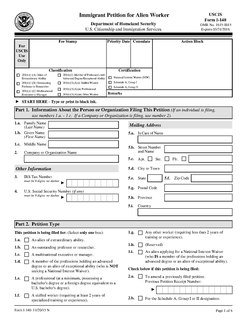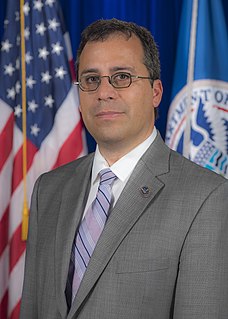
A green card, known officially as a permanent resident card, is an identity document which shows that a person has permanent residency in the United States. Green card holders are formally known as lawful permanent residents (LPRs). As of 2019, there are an estimated 13.9 million green card holders of whom 9.1 million are eligible to become United States citizens. Approximately 65,000 of them serve in the U.S. Armed Forces.
The H-1B is a visa in the United States under the Immigration and Nationality Act, section 101(a)(15)(H) that allows U.S. employers to temporarily employ foreign workers in specialty occupations. A specialty occupation requires the application of specialized knowledge and a bachelor's degree or the equivalent of work experience. The duration of stay is three years, extendable to six years; after which the visa holder may need to reapply. Laws limit the number of H-1B visas that are issued each year: 188,100 new and initial H-1B visas were issued in 2019. Employers must generally withhold Social Security and Medicare taxes from the wages paid to employees in H-1B status.

The Diversity Immigrant Visa program, also known as the green card lottery, is a United States government lottery program for receiving a United States Permanent Resident Card. The Immigration Act of 1990 established the current and permanent Diversity Visa (DV) program.

The Immigration Act of 1990 was signed into law by George H. W. Bush on November 29, 1990. It was first introduced by Senator Ted Kennedy in 1989. It was a national reform of the Immigration and Nationality Act of 1965. It increased total, overall immigration to allow 700,000 immigrants to come to the U.S. per year for the fiscal years 1992–94, and 675,000 per year after that. It provided family-based immigration visa, created five distinct employment based visas, categorized by occupation, and a diversity visa program that created a lottery to admit immigrants from "low admittance" countries or countries whose citizenry was underrepresented in the U.S.
A K-1 visa is a visa issued to the fiancé or fiancée of a United States citizen to enter the United States. A K-1 visa requires a foreigner to marry his or her U.S. citizen petitioner within 90 days of entry, or depart the United States. Once the couple marries, the foreign citizen can adjust status to become a lawful permanent resident of the United States. Although a K-1 visa is legally classified as a non-immigrant visa, it usually leads to important immigration benefits and is therefore often processed by the Immigrant Visa section of United States embassies and consulates worldwide.
U.S. Citizenship and Immigration Services (USCIS) is an agency of the United States Department of Homeland Security (DHS) that administers the country's naturalization and immigration system. It is a successor to the Immigration and Naturalization Service (INS), which was dissolved by the Homeland Security Act of 2002 and replaced by three components within the DHS: USCIS, Immigration and Customs Enforcement (ICE), and Customs and Border Protection (CBP).
The United States EB-5 visa, employment-based fifth preference category or EB-5 Immigrant Investor Visa Program, created in 1990 by the Immigration Act of 1990, provides a method for eligible Immigrant Investors to become lawful permanent residents—informally known as "green card" holders—by investing substantial capital to finance a business in the United States that will employ at least 10 American workers. The current investment amount is controversial as USCIS has not updated their website nor issued guidance in light of a federal judge, in June 2021, striking down the 2019 EB-5 “modernization” regulation. The judge found the 2019 regulation which increased the investment threshold from $500,000 to $900,000 invalid as it was enacted by government officials not properly appointed to their post in violation of the 1998 Federal Vacancies Reform Act (FVRA).
EB-2 is an immigrant visa preference category for United States employment-based permanent residency, created by the Immigration Act of 1990. The category includes "members of the professions holding advanced degrees or their equivalent", and "individuals who because of their exceptional ability in the sciences, arts, or business will substantially benefit prospectively the national economy, cultural or educational interests, or welfare of the United States, and whose services in the sciences, arts, professions, or business are sought by an employer in the United States". Applicants must generally have an approved labor certification, a job offer, and their employer must have filed an Immigrant Petition for Alien Worker with the USCIS.
Immigrant investor programs are programs that allow individuals to obtain residence or citizenship of a country in return for making qualifying investments.
The Startup Visa is a temporary conditional residence permit in different countries. It aims at introducing a visa category for entrepreneurs raising outside funding and converts to a permanent residency visa if certain conditions are met.
The New York City Regional Center (NYCRC) secures capital for real estate and infrastructure projects throughout New York City. Established in 2008, NYCRC has provided over $1.5 billion of capital to help fund a broad spectrum of economic development projects in Brooklyn, Queens, Manhattan, and the Bronx. These projects have successfully utilized NYCRC financing to assist in the construction of over 3.5 million square feet of new development and renovation as well as infrastructure upgrades resulting in thousands of new jobs for New Yorkers.
A Targeted Employment Area (TEA) is a region of the United States for which the threshold for investment for an investor to be eligible for the EB-5 visa is $900,000. There are two kinds of TEAs: high unemployment areas and rural areas.
The American Competitiveness in the 21st Century Act (AC21) was an act passed by the government of the United States in October 2000, pertaining to immigration to the United States. It was a complement to the American Competitiveness and Workforce Improvement Act that had been passed in 1998. The focus of AC21 was to change rules related to portability and caps for the H-1B visa to increase the effective number of visas available and make it easier for workers on those visas to switch jobs. Although the language of the Act references the Immigration and Naturalization Service (INS), the INS would soon be restructured and the functions of the INS referenced in AC21 would be handled by United States Citizenship and Immigration Services.
Premium Processing Service refers to an optional premium service offered by the United States Citizenship and Immigration Services to employers filing Form I-129 or Form I-140. To avail of the service, the employer needs to file Form I-907 and include a fee that is $1,500 for the H-2B and R classifications and $2,500 for all others.
China City of America is a multi-phased construction project planned for the town of Thompson, Sullivan County, in the Catskill Mountains region of the U.S. state of New York. The current project, Thompson Education Center (TEC), is a proposed for-profit college for foreign students, situated in a 573-acre parcel which borders a state-protected wetland.
The United States Citizenship and Immigration Services is a subdivision of the U.S. Department of Homeland Security that adjudicates petitions and processes forms related to citizenship, residency, and various kinds of authorization to live and work in the United States. Many of the forms it processes are prerequisites for people outside the United States who are not United States citizens or permanent residents to obtaining visas to enter the United States in the specified status. Many of the USCIS immigration forms have long processing times. The USCIS offers some guidance regarding expected processing times through its website and through reports. This page describes the USCIS policies, the guidance they offer, and the courses of action in case of higher processing times.
The National Visa Center (NVC) is a center that is part of the U.S. Department of State that plays the role of holding United States immigrant visa petitions approved by the United States Citizenship and Immigration Services until an immigrant visa number becomes available for the petition, at which point it arranges for the visa applicant(s) to take the visa interview at a consulate abroad. It is located in Portsmouth, New Hampshire. It was established on July 26, 1994 on the site of an Air Force base that was closed down by The Pentagon.

Form I-140, Immigrant Petition for Alien Worker is a form submitted to the United States Citizenship and Immigration Service (USCIS) by a prospective employer to petition an alien to work in the US on a permanent basis. This is done in the case when the worker is deemed extraordinary in some sense or when qualified workers do not exist in the US. The employer who files is called the petitioner, and the alien employee is called the beneficiary; these two can coincide in the case of a self-petitioner. The form is 6 pages long with a separate 10-page instructions document as of 2016. It is one of the USCIS immigration forms.

Lee Francis Cissna is an American lawyer and government official who served as Director of United States Citizenship and Immigration Services from 2017 to 2019. Prior to assuming that role, he was the Director of Immigration Policy in the Office of Policy of the U.S. Department of Homeland Security.

The U.S. Citizenship Act of 2021 is a legislative bill that was proposed by President Joe Biden on his first day in office. It was formally introduced in the House by Representative Linda Sánchez.








